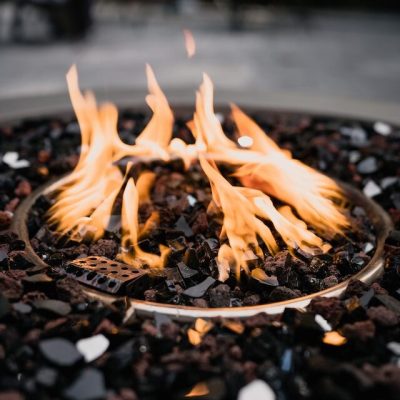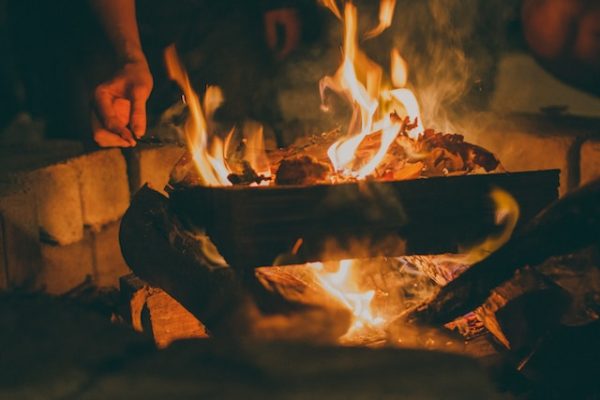Thinking about spicing up your backyard with an outdoor fire pit? You might be stuck choosing between gas and wood outdoor firepit. Each has its own perks and downsides, making it a decision that requires some more thought. Let’s break down the pros and cons of both so you can make an informed decision.
What is a Gas Fire Pit?
A gas fire pit is a type of outdoor heating and recreational feature that uses gas as its fuel source to produce flames. It’s designed to mimic the look and ambiance of a traditional wood-burning fire pit but operates using either natural gas or propane. Gas fire pits typically consist of a burner, a mechanism to regulate the flow of gas, and decorative elements like lava rocks or fire glass to enhance the appearance of the flames.

Advantages of a gas fire pit
Here are some of the benefits of using a gas fire pit:
- Convenience: One of the key advantages of gas fire pits is their convenience. You can ignite or extinguish the flames with a switch or knob. This eliminates the need to gather, store, or manage firewood, streamlining the setup and maintenance process.
- Ease of Control: Gas fire pits provide ease of control over the flame size and intensity. Many models come equipped with adjustable knobs, giving you the freedom to tailor the flame height according to your preferences and the surrounding conditions.
- Enhanced Safety: Gas fire pits do not emit sparks and embers, making them a low care and simple solution for outdoor gatherings.
- Instant Ignition and Shutdown: Gas fire pits ignite promptly and can be turned off just as quickly. This feature is especially beneficial when you want to enjoy a fire for a brief period without building, maintaining, and extinguishing a wood fire. In addition, this can help in challenging conditions like wind or dampness that can complicate lighting a wood fire.
Disadvantages of a gas fire pit
Here are some of the disadvantages of using a gas fire pit:
- Less Authentic Ambiance: Gas fire pits lack the authentic crackling sounds, aroma, and visual appeal of burning wood. Some people prefer the traditional charm of a wood-burning fire for its sensory experience.
- Limited Aesthetic Variety: Gas fire pits can be limited in terms of the types of flames they produce and the visual effects they create – appearing more uniform and controlled. Wood fires offer a broader range of flame heights, colors, and patterns that can be challenging to replicate with gas.
- Initial Installation Cost: Gas fire pits can require a higher upfront investment compared to simpler wood fire pit setups. This is due to the cost of the gas line installation, burner components, and sometimes professional installation.
- Dependency on Fuel Supply: Gas fire pits rely on a consistent supply of propane or natural gas. If the gas supply is interrupted, you won’t be able to use the fire pit until the supply is restored.
- Maintenance of Gas Lines: Gas fire pits require proper maintenance of gas lines, valves, and other components to ensure safety and optimal functionality. This might involve occasional inspections and upkeep.
- Heat Output Limitations: Gas fire pits might have limitations in terms of heat output compared to larger wood fires, which can produce more intense heat. This might affect their effectiveness in very cold weather.
- Limited Cooking Options: Unlike some wood fire pits, gas fire pits may not be well-suited for cooking or grilling, as they lack the same level of direct heat that wood fires can provide.
What is a Wood Fire Pit?
A wood fire pit is an outdoor heating and recreational feature that uses wood as its primary fuel source to produce flames. It’s designed to create a warm and inviting ambiance, typically consisting of a circular or bowl-shaped container where wood logs are burned. Wood fire pits are often constructed with heat-resistant materials like steel, cast iron, or stone to ensure safety and durability.

Advantages of a wood fire pit
Here are some of the benefits of using an outdoor wood burning fire pit:
- Authentic Ambiance: Wood fire pits provide a genuine and rustic atmosphere, complete with crackling sounds, the scent of burning wood, and the visual charm of dancing flames. This authentic experience can be especially appealing for those who value traditional outdoor fires.
- Economical Fuel Source: Burning wood can be more cost-effective than using gas, especially if you have access to a supply of firewood. This can make wood fire pits a budget-friendly option for outdoor heating.
- High Heat Output: Wood fires tend to generate higher heat levels compared to gas fire pits, making them suitable for colder evenings when you need substantial warmth.
- Customizable Flames: Different types of wood can produce varying flame heights, colors, and patterns, allowing you to customize the fire’s appearance to match your preferences.
- Versatility in Cooking: Some wood fire pits are designed with cooking in mind. You can grill food, toast marshmallows, or cook meals over an open flame, enhancing the outdoor dining experience.
- Connection to Nature: Gathering, chopping, and storing firewood can connect you with nature and provide a sense of accomplishment that comes from self-sufficient activities.
- No Dependency on Fuel Supply: Unlike gas fire pits that rely on a steady supply of gas, wood fire pits can be used without dependence on external resources, making them suitable for locations without gas access.
Disdvantages of a wood fire pit
Here are some of the disadvantages of using a wood fire pits:
- Long Ignition Process: Lighting a wood fire pit can take time, especially if you’re starting from scratch. This might not be ideal if you’re looking for a quick source of warmth or ambiance.
- Mess and Cleanup: Wood fire pits generate ash, embers, and debris that require regular cleaning and maintenance. The cleanup process can be time-consuming and may involve disposing of ashes properly.
- Smoke and Odor: Wood fires produce smoke that can be bothersome to some people, and the lingering odor of smoke might permeate your clothes and surroundings.
- Ignition Challenges: Lighting a wood fire can be more challenging, especially in windy or damp conditions. You’ll need to gather kindling, paper, and sometimes starter logs to ensure a successful ignition.
- Time and Effort: Gathering, chopping, and storing firewood can be labor-intensive and time-consuming, requiring ongoing effort to ensure a sufficient supply.
- Firewood Storage: Storing firewood requires ample space and protection from the elements to ensure the wood remains dry and usable. Improperly stored wood can become damp and difficult to ignite.
- Air Quality Impact: Wood burning can contribute to air pollution, especially if you burn unseasoned or improperly cured wood. This might not be suitable for areas with poor air quality or during burn bans.
Conclusion
Considering these advantages and disadvantages of gas and wood outdoor fire pits will help you make an informed decision based on your preferences, lifestyle, and the specific conditions of your outdoor space.